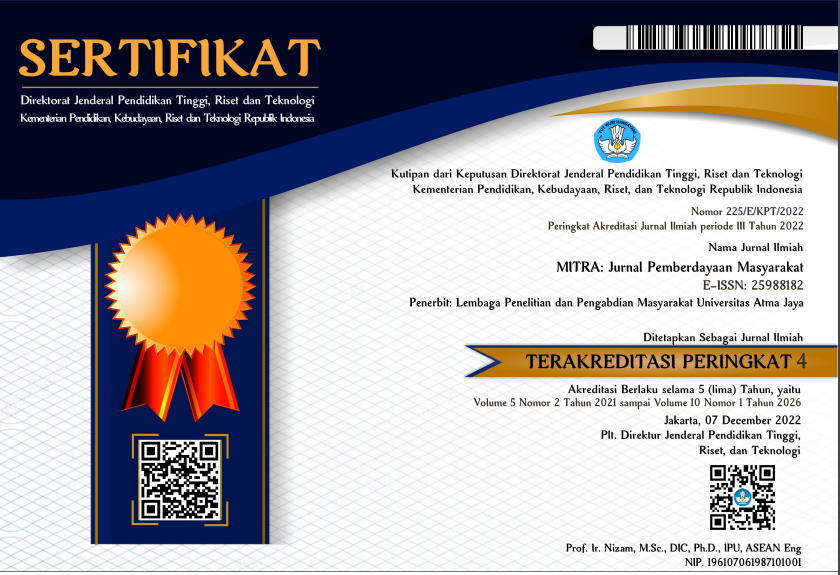The Community Empowerment in Kelapa Dua, Depok, through Hygiene Tempeh Production Training
DOI:
https://doi.org/10.25170/mitra.v6i1.2192Kata Kunci:
soybeans, empowerment of housewives, tempehAbstrak
Many people from various communities still do not understand the value of tempeh as a healthy food item. Therefore, to improve the public knowledge about the nutritional values of tempeh, Atma Jaya Catholic University of Indonesia chose the community of Bhayangkari women from Ranting, Kelapa Dua, Depok, as the target partners in the community service program. This community, which consisted of housewives of police officers, was considered the right target because they had the role of providing healthy food for their families. In addition to providing knowledge about the importance of consuming tempeh as healthy food, the team also trained the community to produce hygienic tempeh. The activities included three stages, i.e., preparation, implementation, and monitoring and evaluation. The program preparation involved the registration of the participants, the preparation of the seminar materials, and the procurement of materials and tools for the tempeh production. Next, the implementation stage consisted of education and training activities conducted via WhatsApp (WA) and Zoom meetings. Finally, the monitoring and evaluation stage was conducted via WA to assess the tempeh production process. Through this community service program, it is evident that all the participants could be trained on how to make hygienic tempeh easily. The guidelines to produce tempeh were also easy to understand and readily available for public use. Overall, the participants became more aware of the health benefits of tempeh.
Referensi
Fierdor, J., & Burda, K. (2014). Potential role of carotenoids as antioxidants in human health and disease. Nutrients, 6(2), 466-488. https://doi.org/10.3390/nu6020466.
Gunawan AW, dan Hartanti AT. 2018. Biologi dan bioteknologi cendawan dalam praktik.Jakarta (ID): Penerbit Universitas Atma Jaya.https://books.google.com/books?hl=en&lr=&id=jLizDwAAQBAJ&oi=
fnd&pg=PR7 &dq=bioteknologi+cendawan+tatik&ots=Jb8zQJEyZ&sig=
SpTS8u2ieSdziGlH8JH9fiVZx_Q.
Haron, H., Ismail, A., Azlan, A., Shahar, S., & Peng, L. S. (2009). Daidzein and genestein contents in tempeh and selected soy products. Food Chemistry, 115(4), 1350-1356. https://doi.org/10.1016/j.foodchem.2009.01.053.
Hartanti, A. T., Rahayu, G., & Hidayat, I. (2015). Rhizopus species from fresh tempeh collected from several regions in Indonesia. Hayati Journal of Biosciences, 22(3), 136-142. https://doi.org/10.1016/j.hjb.2015.10.004.
Keuth, S., & Bisping, B. (1994). Vitamin B12 production by Citrobacter freundii or Klebsiella pneumoniae during tempeh fermentation and proof of enterotoxin absence by PCR. Applied and environmental microbiology, 60(5), 1495-1499.
https://doi.org/10.1128/aem.60.5.1495-1499.1994.
Kiers, J. L., Nout, M. J. R., Rombouts, F. M., Nabuurs, M. J. A., & Van der Meulen, J. (2002). Inhibition of adhesion of enterotoxigenic Escherichia coli K88 by soya bean tempe. Letters in applied microbiology, 35(4), 311-315. https://doi.org/10.1046/j.1472-765X.2002.01182.x.
Kiers, J. L., Nout, R. M. J., & Rombouts, F. M. (2000). In vitro digestibility of processed and fermented soya bean, cowpea and maize. Journal of the Science of Food and Agriculture, 80(9), 1325-1331. https://doi.org/10.1002/1097-
0010(200007)80:9%3C1325::AID-JSFA648%3E3.0.CO;2-K
.
Soka, S., Suwanto, A., Sajuthi, D., & Rusmana, I. (2014). Impact of tempeh supplementation on gut microbiota composition in Sprague-Dawley rats. Research Journal of Microbiology, 9(4), 189. https://doi.org/jm.2014.189.198.
Stephanie, S., Ratih, N. K., Soka, S., & Suwanto, A. (2017). Effect of tempeh supplementation on the profiles of human intestinal immune system and gut microbiota. Microbiology Indonesia, 11(1), 2. https://doi.org/10.5454/mi.11.1.2.
Unduhan
Diterbitkan
Cara Mengutip
Terbitan
Bagian
Lisensi
This license allows reusers to distribute, remix, adapt, and build upon the material in any medium or format for noncommercial purposes only, and only so long as attribution is given to the creator. If you remix, adapt, or build upon the material, you must license the modified material under identical terms.







_.jpeg)




.png)
2.png)
.png)
.png)



